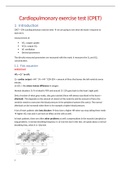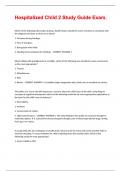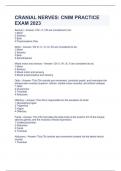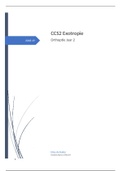Summary Biomolecular Spectroscopy
Lecture 1: Introduction
Optical spectroscopy:
- Using photons (light) to gain information on molecules
- Interaction of electromagnetic radiation with matter
- Purposes:
o Identify compounds
o Quantitation of compounds
o Study of physicochemical properties of compounds and their surrounding
Interaction of light with matter:
- No interaction
- Light is absorbed → intensity of light going down
o All light is absorbed except the color which is visible
- Light is transmitted
o Daylight is transmitted through window (UV light is not transmitted by glass)
- Light is reflected or scattered → change of direction of light
o Reflection makes things visible (daylight reflects)
o Glass of milk very bright white as light is scattered in all directions
Electromagnetic radiation:
- UV: 10 – 380 nm
- Visible: 380 – 780 nm
- IR: 1 – 200 nm
- IR not visible → not enough energy to see it
- UV light → much higher energy but still not visible → eyes have a layer which is not
transparent for UV light (prevent damage)
Interactions used for spectroscopy:
- UV/VIS radiation: pi-electrons and free electron pairs → transitions between
electronic energy states
- IR radiation: molecular vibrations → transitions between vibrational energy states
- Radio radiation: nuclear spin of atoms → transition between spin energy states
,Electron spectroscopy: UV/Vis (aborption) and fluorescence (emission)
Vibrational spectroscopy: IR (absorption of IR) and Raman (scatter of UV, Vis or IR)
Properties of light:
- Oscillation of electric field propagating through space
- Wavelength () = speed (v) / frequency ()
- Energy (E in J per photon) = Plank (h = 6.626*10-34 Js) * frequency ()
- Wavenumber () = 1 / wavelength () in cm-1
- Amplitude: relates to intensity → higher intensity results in larger amplitude
- Often wavelength scale, but from molecular perspective it would be more relevant to
use photon energy (frequency) scales
- Speed of light in vacuum: c = 2.998 x 108 m/s
- Speed of light depends on medium in which it is propagating
- Refractive index: n = c / v
o Air: 1.003
o Water: 1.333
o Glass: 1.5
o Always > 1 → cannot be faster than in vacuum (free space)
Polarization of light:
- For normal unpolarized light: plane of electric field vector is randomly distributed
- Plane-polarized or linearly polarized light: the plane of electric field vector is fixed →
one direction only
- Polarizers: selection from non-polarized light → only transmits light in one plane →
result is plane polarized light
- Polarimetry: measurement of rotation of plane polarized light by optically active
substance
o Determination of chirality, chiral excess, concentration of chiral compound
- Circular polarized light: plane of electric field vector rotates about its propagation
direction
o Can be seen as resultant of two perpendicular
plane-polarized waves with identical frequency
and direction, but a phase difference of 90
o Phase difference 0 – 180: plane-polarized
o Phase difference 0 – 90: elliptically polarized
- Circular dichroism: measurement of difference in absorption of left- and right-
handed circularly polarized light by optically active substance
o Needs chromophore
o Measures difference in absorbance → often very small
o Often used for analysis of protein secondary structure → beta sheets, alpha
helix, random coil → CD spectra will be different
,Reflection and refraction:
- Part of ray reflects on the interface of media of
different refractive index
- Part of ray bends towards normal when it enters
medium of higher refractive index
- Specular reflection: angle of incidence equals
angle of reflection (1 = 3)
- Refraction: Snell’s law:
n1 sin(1) = n2 sin(2)
- Reflection at interfaces causes loss of transmitted light
o % reflectance = ((n2 – n1) / (n2 + n1))2 * 100
o Glass does not transmit 100% of the light
- Reflection at interfaces may cause (partial) polarization
o Increase incident angle → more will be reflected
o Brewster angle: point where no light is reflected
▪ Vertically polarized light is totally transmitted
▪ Reflected beam is fully polarized (horizontally)
- From higher to lower n: total internal reflection
Above critical angle the beam is totally reflected at interface
Applications:
- Rainbow: result of total internal reflection and refraction
- Evanescent wave: light totally reflecting from a surface actually penetrates a very
short distance into the 2nd medium → absorption in 2nd medium leads to decrease in
intensity of reflected beam
o Applications: analysis of thin films, high concentration, solids pastes; selective
measurement of molecules adsorbed on surface, mostly used in IR
spectroscopy using IR transparent medium
- Absorption spectrophotometry: measuring light absorption
o Transmission: intensity going through / intensity going in
o Absorbance A = –log(T) = * c * l
Lecture 2: Basic aspects
- Rays: straight lines staring at light source vision → diffuse reflection on rough
surfaces
- Waves: diffraction → bending around edges
- Bundle of photons: ‘particles’ without mass, but with energy
- Spectroscopy: one photon collides with one molecule (and absorbs or not)
, Light:
- Wave that passes through vacuum → electricity is able to do that (no mass-waves)
- Electric field E(t) perpendicular to direction of propagation → changing magnitude
and direction
- Perpendicular on E(t), magnetic field H(t) → ring current produces magnet
Photoelectric effect:
- Light beam on method → emitted electrons
- Kin. E is independent of light intensity: KE = ½ mv2 = hv – hv0 v0: threshold freq.
- Electrons are only emitted if wavelength is sufficiently short
o Expected:
▪ Higher intensity: more electrons, higher rate (kin. E)
▪ Change of velocity: no effect on kin. E
o Observed:
▪ Higher intensity: no increase of kin. E
▪ Increase of velocity: kin. E increases
▪ Threshold of velocity: too low → no emitted electrons
- Classical waves: transfer energy from particle to particle
o Rate of transfer amplitude2
o Intensity = power/area amplitude2/area
- Electromagnetic wave (light):
o Rate of transfer energy/photon
o Intensity = number of photons that pass through area in one second
- So only (=c/) determine energy of photon
o Enhancement of intensity → increase number of photons
- Number of electrons removed depends on light intensity
o Photon energy of 700 nm red light (figure) is
insufficient to remove electron from metal surface
o Light is bundle of photons with energy per photon
determined by wavelength
o Intensity is determined by number of photons
o Upon collision of photon with sufficient energy an
electron exits from the metal
Photon:
𝑚0
- Has no mass → 𝑚 =
√1−𝜈2⁄𝑐2
o As c = for a photon → would imply that m reaches infinity → unacceptable,
so rest mass m0 = 0
𝐸 𝑚𝑐 2 ℎ𝜈
- Has momentum 𝑚𝑐 = = =
𝑐 𝑐 𝑐
Wave character of particles:
- Nanoscopic scale: light wave has particle character
- Energy is quantitized:
o Photon has particular energy
o Molecule/atom has particular energy; E1, E2, E3, …
Lecture 1: Introduction
Optical spectroscopy:
- Using photons (light) to gain information on molecules
- Interaction of electromagnetic radiation with matter
- Purposes:
o Identify compounds
o Quantitation of compounds
o Study of physicochemical properties of compounds and their surrounding
Interaction of light with matter:
- No interaction
- Light is absorbed → intensity of light going down
o All light is absorbed except the color which is visible
- Light is transmitted
o Daylight is transmitted through window (UV light is not transmitted by glass)
- Light is reflected or scattered → change of direction of light
o Reflection makes things visible (daylight reflects)
o Glass of milk very bright white as light is scattered in all directions
Electromagnetic radiation:
- UV: 10 – 380 nm
- Visible: 380 – 780 nm
- IR: 1 – 200 nm
- IR not visible → not enough energy to see it
- UV light → much higher energy but still not visible → eyes have a layer which is not
transparent for UV light (prevent damage)
Interactions used for spectroscopy:
- UV/VIS radiation: pi-electrons and free electron pairs → transitions between
electronic energy states
- IR radiation: molecular vibrations → transitions between vibrational energy states
- Radio radiation: nuclear spin of atoms → transition between spin energy states
,Electron spectroscopy: UV/Vis (aborption) and fluorescence (emission)
Vibrational spectroscopy: IR (absorption of IR) and Raman (scatter of UV, Vis or IR)
Properties of light:
- Oscillation of electric field propagating through space
- Wavelength () = speed (v) / frequency ()
- Energy (E in J per photon) = Plank (h = 6.626*10-34 Js) * frequency ()
- Wavenumber () = 1 / wavelength () in cm-1
- Amplitude: relates to intensity → higher intensity results in larger amplitude
- Often wavelength scale, but from molecular perspective it would be more relevant to
use photon energy (frequency) scales
- Speed of light in vacuum: c = 2.998 x 108 m/s
- Speed of light depends on medium in which it is propagating
- Refractive index: n = c / v
o Air: 1.003
o Water: 1.333
o Glass: 1.5
o Always > 1 → cannot be faster than in vacuum (free space)
Polarization of light:
- For normal unpolarized light: plane of electric field vector is randomly distributed
- Plane-polarized or linearly polarized light: the plane of electric field vector is fixed →
one direction only
- Polarizers: selection from non-polarized light → only transmits light in one plane →
result is plane polarized light
- Polarimetry: measurement of rotation of plane polarized light by optically active
substance
o Determination of chirality, chiral excess, concentration of chiral compound
- Circular polarized light: plane of electric field vector rotates about its propagation
direction
o Can be seen as resultant of two perpendicular
plane-polarized waves with identical frequency
and direction, but a phase difference of 90
o Phase difference 0 – 180: plane-polarized
o Phase difference 0 – 90: elliptically polarized
- Circular dichroism: measurement of difference in absorption of left- and right-
handed circularly polarized light by optically active substance
o Needs chromophore
o Measures difference in absorbance → often very small
o Often used for analysis of protein secondary structure → beta sheets, alpha
helix, random coil → CD spectra will be different
,Reflection and refraction:
- Part of ray reflects on the interface of media of
different refractive index
- Part of ray bends towards normal when it enters
medium of higher refractive index
- Specular reflection: angle of incidence equals
angle of reflection (1 = 3)
- Refraction: Snell’s law:
n1 sin(1) = n2 sin(2)
- Reflection at interfaces causes loss of transmitted light
o % reflectance = ((n2 – n1) / (n2 + n1))2 * 100
o Glass does not transmit 100% of the light
- Reflection at interfaces may cause (partial) polarization
o Increase incident angle → more will be reflected
o Brewster angle: point where no light is reflected
▪ Vertically polarized light is totally transmitted
▪ Reflected beam is fully polarized (horizontally)
- From higher to lower n: total internal reflection
Above critical angle the beam is totally reflected at interface
Applications:
- Rainbow: result of total internal reflection and refraction
- Evanescent wave: light totally reflecting from a surface actually penetrates a very
short distance into the 2nd medium → absorption in 2nd medium leads to decrease in
intensity of reflected beam
o Applications: analysis of thin films, high concentration, solids pastes; selective
measurement of molecules adsorbed on surface, mostly used in IR
spectroscopy using IR transparent medium
- Absorption spectrophotometry: measuring light absorption
o Transmission: intensity going through / intensity going in
o Absorbance A = –log(T) = * c * l
Lecture 2: Basic aspects
- Rays: straight lines staring at light source vision → diffuse reflection on rough
surfaces
- Waves: diffraction → bending around edges
- Bundle of photons: ‘particles’ without mass, but with energy
- Spectroscopy: one photon collides with one molecule (and absorbs or not)
, Light:
- Wave that passes through vacuum → electricity is able to do that (no mass-waves)
- Electric field E(t) perpendicular to direction of propagation → changing magnitude
and direction
- Perpendicular on E(t), magnetic field H(t) → ring current produces magnet
Photoelectric effect:
- Light beam on method → emitted electrons
- Kin. E is independent of light intensity: KE = ½ mv2 = hv – hv0 v0: threshold freq.
- Electrons are only emitted if wavelength is sufficiently short
o Expected:
▪ Higher intensity: more electrons, higher rate (kin. E)
▪ Change of velocity: no effect on kin. E
o Observed:
▪ Higher intensity: no increase of kin. E
▪ Increase of velocity: kin. E increases
▪ Threshold of velocity: too low → no emitted electrons
- Classical waves: transfer energy from particle to particle
o Rate of transfer amplitude2
o Intensity = power/area amplitude2/area
- Electromagnetic wave (light):
o Rate of transfer energy/photon
o Intensity = number of photons that pass through area in one second
- So only (=c/) determine energy of photon
o Enhancement of intensity → increase number of photons
- Number of electrons removed depends on light intensity
o Photon energy of 700 nm red light (figure) is
insufficient to remove electron from metal surface
o Light is bundle of photons with energy per photon
determined by wavelength
o Intensity is determined by number of photons
o Upon collision of photon with sufficient energy an
electron exits from the metal
Photon:
𝑚0
- Has no mass → 𝑚 =
√1−𝜈2⁄𝑐2
o As c = for a photon → would imply that m reaches infinity → unacceptable,
so rest mass m0 = 0
𝐸 𝑚𝑐 2 ℎ𝜈
- Has momentum 𝑚𝑐 = = =
𝑐 𝑐 𝑐
Wave character of particles:
- Nanoscopic scale: light wave has particle character
- Energy is quantitized:
o Photon has particular energy
o Molecule/atom has particular energy; E1, E2, E3, …








